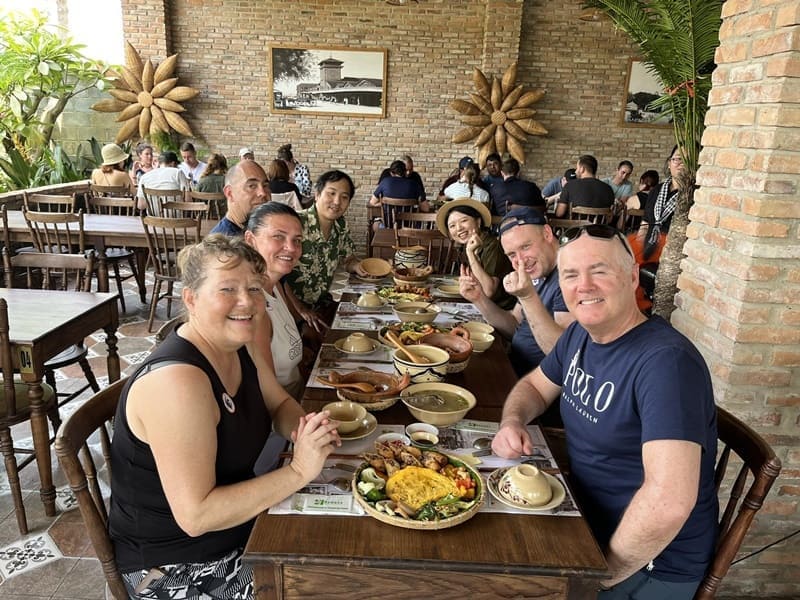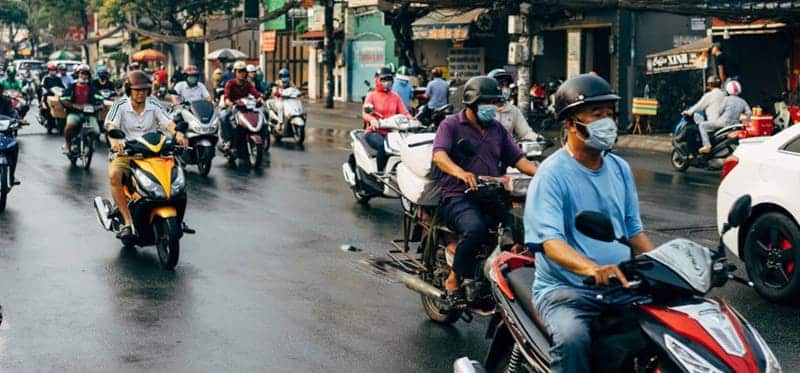You should not come to Vietnam because you will be fascinated and not want to leave. This place is famous for its historical tourist attractions, outdoor sightseeing, and diverse cuisine. Below are 5 reasons not to go to Vietnam.
Diverse cuisine
First reason not to come to Vietnam is the diverse cuisine. Vietnam is a gem in Southeast Asia, not only for its breathtaking landscapes and rich history but also for its diverse cuisine. One of the top reasons to visit this vibrant country is the opportunity to indulge in a plethora of mouth-watering dishes that showcase the unique flavors and ingredients of each region.

Street food delights
When exploring the bustling streets of Vietnam, one cannot help but be drawn in the tantalizing aroma of street food wafting from every corner. Here are some delicious street foods in Vietnam that you must try.
Pho
A fragrant and flavorful noodle soup, usually served with tender slices of beef or chicken, fresh herbs, and a squeeze of lime. Attractive dishes suitable for any time of the day.
Banh mi
A delicious Vietnamese sandwich made with a crispy baguette, filled with a variety of meats, pate, pickled vegetables, and a spicy chili sauce. The harmonious blend of flavors will make you unforgettable and want to eat continuously.
Bun cha
Bun Cha is mainly made from grilled pork, eaten with vermicelli and herbs. The special feature of Bun Cha is the fragrant and sweet dipping sauce. This dish is a favorite among locals and visitors alike for its smoky grilled flavor.
Regional specialties
Each region in Vietnam boasts its own unique culinary traditions and specialties. Here are some regional dishes that you should not miss.
Hue’s imperial cuisine
Delve into the royal flavors of Hue, where intricate and artfully prepared dishes such as Banh Khoai (crispy pancake with shrimp and pork) and Bun Bo Hue (spicy beef noodle soup) reign supreme.
Hoi An’s Cao Lau
A specialty of the ancient town of Hoi An, Cao Lau is a noodle dish that combines Chinese, Japanese, and Vietnamese influences. The secret to its distinct flavor lies in the use of unique water from ancient Cham wells.
Saigon’s Com Tam
Known as broken rice, this popular dish features tender grilled pork chops, a fried egg, pickled vegetables, and fish sauce. A comforting and satisfying meal that perfectly encapsulates the essence of Saigon.
Rich cultural heritage
Rich cultural heritage is one of the reasons not to go to Vietnam because you will be fascinated. Vietnam is a country brimming with a rich cultural heritage that dates back centuries. From ancient temples and pagodas to colonial architecture, the country offers a glimpse into its unique history and traditions.
Ancient temples and pagodas
Vietnam is known as a country with a long history and culture of thousands of years. Among its many treasures are the ancient temples and pagodas that reflect its rich heritage.
My Son Sanctuary

Located in central Vietnam, My Son Sanctuary is a UNESCO World Heritage site of the ancient Champa civilization. The intricate Hindu temples are a testament to the advanced architectural skills of the Champa people.
Huong Pagoda
Nestled in the Huong Tich mountains, the Huong Pagoda is a complex of Buddhist temples and shrines set against a stunning natural backdrop. Visitors can take a boat ride along the Huong River to reach the pagoda.
Temple of Literature
Situated in Hanoi, the Temple of Literature is a well-preserved example of traditional Vietnamese architecture. Originally built as a Confucian temple, it now honors scholars and literary figures.
Colonial architecture
The architectural legacy of Vietnam’s colonial past is a captivating blend of elegance and history. From the charming French Quarter in Hanoi to the iconic Saigon Notre-Dame Basilica in Ho Chi Minh City, these structures stand as a testament to the country’s rich cultural heritage.
French Quarter in Hanoi
Wander through the tree-lined boulevards of the French Quarter in Hanoi and be transported back in time to the days of French colonization. Admire the grand colonial buildings that still grace the streets, each telling a story of Vietnam’s complex history.
Saigon Notre-Dame Basilica
In Ho Chi Minh City, the Saigon Notre-Dame Basilica stands tall as a striking example of French Gothic architecture. The red-brick cathedral is not only a religious symbol but also a representation of the city’s cultural diversity, blending Vietnamese and French influences seamlessly.
Hoi An Ancient Town
Travel to Hoi An Ancient Town and be enchanted by its well-preserved trading port, a melting pot of Vietnamese, Chinese, and Japanese influences. The quaint streets lined with traditional houses offer a glimpse into the past, making it a must-visit destination for tourists seeking to immerse themselves in Vietnam’s rich history.
Cheap transportation
Vietnam is a country that offers not just beautiful landscapes and rich culture but also cheap and efficient transportation options. Everyone doesn’t need to worry about the cost when traveling in this beautiful country. Let’s take a closer look at two popular modes of transport that won’t break the bank.
Motorbike rentals
Motorbikes are, without a doubt, the king of the road here in Vietnam. Renting a motorbike is incredibly affordable and can turn your adventure into an exciting journey of exploration. Motorbike rentals can cost anywhere from $5 to $10 per day. You can even negotiate for a better price if you’re renting for a week or more.

Motorbikes can easily weave through the bustling streets of cities like Hanoi and Ho Chi Minh City or navigate the scenic countryside roads.
A personal tip: Always make sure to wear a helmet and carry your international driving permit. It’s also a good idea to take a practice run in a less busy area before hitting the main roads.
Public buses
If motorbiking isn’t your thing, don’t worry! Vietnam’s public bus system offers a reliable and incredibly affordable alternative. Bus fares within cities are usually between $0.30 to $0.50. Intercity bus fares are also budget-friendly, and you can travel from Hanoi to Ho Chi Minh City for as little as $20.
Public buses cover not only the bustling cities but also remote areas, making it easier for you to get to different tourist spots without spending much.
Many long-distance buses are equipped with reclining seats, air conditioning, and sometimes even Wi-Fi. They offer comfort and convenience, making long journeys more bearable.
Warm and Welcoming People
One of the first things you’ll notice about Vietnam is the warmth and friendliness of its people. From the moment you step off the plane, you’ll be met with genuine smiles and helpful gestures.

Whether you’re checking into a hotel or dining at a local restaurant, you’ll find that the hospitality in Vietnam is second to none. It’s not uncommon for locals to go out of their way to make sure you’re comfortable and happy.
Fresh Ingredients
Vietnamese cuisine is renowned for its vibrant and fresh flavors, which owe a lot to the use of fresh ingredients sourced locally. Let’s take a closer look at some of the cornerstones of Vietnamese cooking herbs and spices, tropical fruits, and seafood.
Herbs and spices
One of the first things you’ll notice in a Vietnamese kitchen is the sheer variety of herbs and spices. From fresh cilantro to aromatic basil, these ingredients play a vital role in the flavor profile of Vietnamese dishes.
Tropical fruits
When it comes to fruits, Vietnam’s tropical climate is a blessing. The country’s markets are brimming with a colorful array of fruits that are both tasty and nutritious. Fruits you can’t miss when traveling to Vietnam: Dragon fruit, mango, rambutan, lychee, papaya, mangosteen…
Seafood
Given its extensive coastline, it’s no wonder Vietnam offers some of the freshest and most diverse seafood. Whether you’re in the north or south, you’ll find seafood dishes that are as varied as they are delicious.
Shrimp found in soups, stir-fries, and even grilled shrimp is a staple in Vietnamese cuisine. Fresh fish, like catfish and snakehead fish, are commonly used in dishes such as “Ca Kho To” (clay pot fish).
Squid often grilled or stir-fried, squid in Vietnam is tender and flavorful, especially when seasoned with a hint of lemongrass and chili.
From crab noodles to crab soup, the taste is rich and slightly sweet. “Bun Rieu Cua” is a famous noodle dish that highlights the succulent flavor of crab.
Clams and Mussels usually steamed with herbs like lemongrass, these shellfish are often enjoyed as appetizers or added to hot pots.
Fresh oysters are typically enjoyed raw with a dash of lemon or grilled with various seasonings.
Conclude
In short, these are the reasons not to go to Vietnam. This is a country filled with historical marvels, breathtaking landscapes, mouth-watering cuisine, friendly people and unique cultural experiences.
So be wary, it may be difficult to leave once you set foot in this charming country. If you want to have great experiences when coming to Vietnam, come to Vietnam Adventure.

 Ms.Lucy
Ms.Lucy